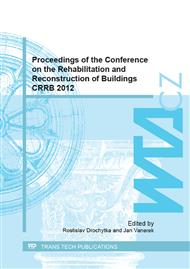p.165
p.172
p.176
p.180
p.185
p.193
p.201
p.207
p.213
Long Term Behaviour of Portland Limestone Cement Concrete Exposed to Combined Chloride and Sulfate Environment. The Effect of Limestone Content and Mineral Admixtures
Abstract:
The long term behaviour of limestone cement concrete, stored in combined chloride and sulfate environment, was studied, taking into consideration the effect of both the limestone content of the cement used and the mineral admixtures addition. Concrete specimens of seven different compositions were prepared. Three of them were made from ordinary Portland cement and from two Portland limestone cements (limestone content: 15% and 35% w/w). The rest four compositions were prepared by substituting a certain amount of the limestone cement (15% w/w limestone content) with natural pozzolana, fly ash, blastfurnace slag or metakaolin. The specimens were immersed in four solutions of various sulfate and chloride contents and stored at 5oC. Visual assessment of the specimens and mass measurements took place up to 55 months. XRD analytical technique was used to identify thaumasite in the deteriorated parts of the specimens. Higher contents of limestone in cement and of sulfates in the storage solutions resulted in more intensive concrete damage. The use of mineral admixtures improved the behaviour of limestone cement concrete. After 24 months of exposure, chlorides delay the deterioration of limestone cement concretes caused by sulfates. After 55 months, the presence of chlorides led to a greater mass loss for them. The specimens containing mineral admixtures showed more intensive deterioration at 24 months when chlorides were present along with sulfates. Their mass seems to not be affected by chlorides. Fly ash was proved as the most efficient material to improve limestone cement concrete's performance, while concrete containing metakaolin suffered from significant damage after 55 months. XRD analysis showed that the damage observed was due to the formation of thaumasite.
Info:
Periodical:
Pages:
185-192
Citation:
Online since:
May 2013
Keywords:
Price:
Сopyright:
© 2013 Trans Tech Publications Ltd. All Rights Reserved
Share:
Citation:


